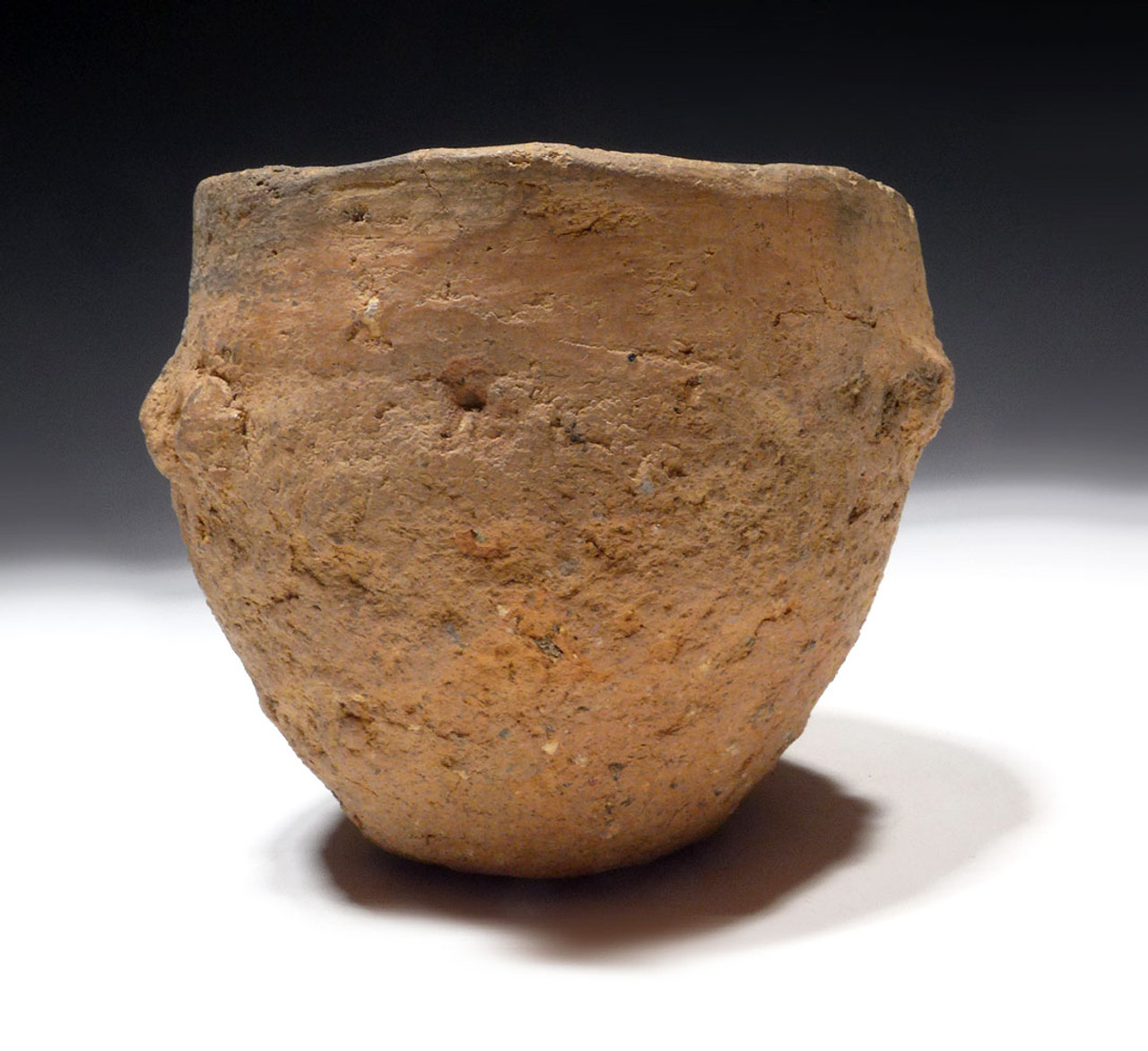Product Description
SEE MORE BRONZE AGE EUROPEAN ARTIFACTS
This is a unique aesthetic ancient ceramic cup of the Urnfield Lusatian (Lausitz) Culture of Central Europe, dating to the Bronze Age. The cup is complete with small lug decorations near the rim. The outer body surface is very rough but it transitions to a smooth rim at the top. There are fundamental design variations of the ceramics of this culture. Some are made with exceptional finishes, colored and burnished with fine glazing, and featuring incised ornamentation. There is another style that is quite strange, though. It is so crude, it is attractive. This type was made with very coarse clay. The way in which they are designed seems so crude that it was done on purpose. We believe it was a deliberate Bronze Age artistic design that the more crude they were, the more attractive they were. We have seen similar ceramics like this where BOTH designs exist on a single ceramic - a beautiful refined portion with a very crude, unfinished lower body so it is most certainly an artistic school of thought.
This ceramic would have been placed inside a larger primary urn to accompany the deceased in the afterlife. It is a fundamental type of secondary pottery to this culture.
Advanced collectors will appreciate this unique opportunity to acquire a RARE European Bronze Age ceramic from an old German private collection. Usually only found in museum collections in Europe, Urnfield pottery of fine condition is extremely rare! This is unique pottery is not of everyday ancient life, but of ancient death and the ritual, religion and burial practices of ancient European peoples of the Bronze Age, into the Early Iron Age.
This piece is in much finer condition than most museum examples. The majority of Urnfield pottery excavated and exhibited in museums is reassembled from mere fragments and requires EXTENSIVE restoration and fabrication. INFINITELY MORE RARE THAN ANY ANCIENT ROMAN OR GREEK POTTERY.
HISTORY
The Urnfield Culture describes a tradition of Late Bronze Age central European societies dating back from 1300 B.C. to 700 B.C.. It gets its name from the practice of cremating the dead, placing the ashes in ceramic pots accompanied by other ceramic vessels, and then burying these pots in fields. These fields became ancient cemeteries and some included hundreds of burials while others were limited to only a few dozen per field. The practice of cremation is believed to have originated from the Balkans. Urnfield societies were based on economies of agriculture and animal husbandry.
The earliest Urnfield Culture societies cremated their dead and then dug graves whereby the ashes were simply scattered in the grave. Later, the practice changed to putting the ashes and bones in a large urn accompanied by other smaller ceramic vessels such as cups, bowls and small dishes. It is possible that food was also placed in this urn, all to be present with the deceased in the afterlife. Occasionally, jewelry is found in the urn which was worn by the deceased and survived the fire, but this is rare. Rich burials included grave gifts of spectacular objects in bronze such as elaborate spiral motif jewelry, fibulae, razors, hammered sheet armor, weapons such as swords, daggers, axes, spears and arrowheads, and vessels. In some cases, the objects like swords, are purposely destroyed as part of a ritual of the burial. The most prized bronze weapon was a sword. Other luxury grave gifts included amber or glass beads, and beautiful gold jewelry and appliqués reserved for the most wealthy and noble classes. Some burials have been found with entire wagons interred with the deceased!
One interesting member of the greater Urnfield Culture was the Lusatian Culture of eastern Europe. In Germany, the culture is known as 'Lausitz', named for the Lusatia area of eastern Germany where sites were first described in the 1800's by German pathologist and archaeologist, Rudolf Virchow (known today as the father of modern pathology). The Lusatian Culture peoples' interred cremated remains in pots to a time beyond central European societies, into the Early Iron Age around 500 B.C.. Lusatian Culture burials usually consist of a main urn that can range from modest sizes up to very large dimensions. In most cases, secondary ceramic vessels are included in the burial urn. The people of the Lusatian Culture were mainly farmers with domestication of animals and supplementing their diet with hunted game. Their settlements existed in both open and fortified plans.
The importance of the European Urnfield Culture is that it displays an ancient human concept of the existence of an afterlife and the cherishing of remains of deceased by loved ones. The placing of remains in a vessel demonstrates care of the deceased by the living. The inclusion of other vessels, accessories and gifts in the burial urn with the ashes, demonstrates the beliefs of these ancient peoples and helps us to delve into their mind, an invaluable insight since no written language existed in their societies at this time.
 US DOLLAR
US DOLLAR
 EURO
EURO
 AUSTRALIAN DOLLAR
AUSTRALIAN DOLLAR
 CANADIAN DOLLAR
CANADIAN DOLLAR
 POUND STERLING
POUND STERLING
















